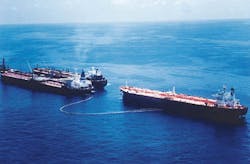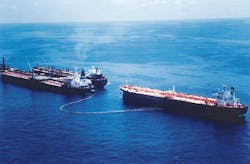FSO fast-track conversion assisted by evaluation, classification
Tough requirements set for Gulf of Mexico FSO
S. Victor Liu
ABS Americas
The Ta'Kuntah FSO, the first FSO installed in the Gulf of Mexico, performing simultaneous offloading on the Cantarell Field off Mexico.The first floating storage and offloading unit for Gulf of Mexico installation was recently classed by ABS Americas, a division of the American Bureau of Shipping (ABS). The task came from Modec (USA), owner of Ta'Kuntah, a converted tanker installed on Pemex's Cantarell Field offshore Mexico.
Within six months of first oil in August 1998, Ta'Kuntah had offloaded some 16 million bbl of oil. Permanently moored in 267 ft of water, the vessel is designed to withstand 100-year hurricane conditions - a necessary requirement for an FSO in the hurricane-prone Gulf of Mexico.
The Ta'Kuntah is ABS classed as an A1 FSO. The floating storage offshore (FSO) vessel notation includes classification of the vessel (structure, stability, marine, utility, safety, and storage systems, and equipment) and the mooring system. Previously known as Juno, the tanker was selected for conversion because of its very large storage capacity, 357,600 dwt tons, a critical requirement for the prolific Cantarell Field. The field will have a production rate of 1.4 million b/d of oil from 35 platforms, after completion of the field's short-term plan.
Capabilities
With a storage capacity of 2.342 million bbl of oil, the vessel is capable of receiving up to 800,000 b/d of crude. The FSO also provides standby storage capacity in the event of inclement weather, as the field's three nearby single point mooring terminals are unable to operate in winds exceeding 40 knots.When the weather is stormy, or winds are high, crude is diverted by pipeline to Ta'Kuntah. The FSO can offload to shuttle tankers both individually and simultaneously. Offloading to one tanker at a time, Ta'Kuntah can transfer up to 55,000 bbl/hour working in tandem, and up to 80,000 bbl/hour side-by-side. With two shuttle tankers working simultaneously, Ta'Kuntah can offload at a rate of 40,000 bbl/hour in tandem or 80,000 bbl/hour side-by-side. This special design capability is possible because crude is received through the turret and offloaded from the deck level.
Modec completed the conversion at Jurong Shipyard in Singapore within an aggressive nine-month schedule. A conversion would normally require 12-15 months, depending on a shipyard's workload. ABS provided the manpower and expertise to complete the engineering design approvals and surveyor monitoring of activities at the yard, suppliers' plants, and the Cantarell site. The surveys included monitoring vessel conversion and installation surveys of the piling, chain, and wire of the mooring system, and the flexible risers.
Fast-track conversion
ABS' involvement in the project began in the early stages, providing recommendations for how to complete the conversion considering all ABS and applicable regulatory requirements, while helping Modec meet requirements for the FSO's Cantarell Field operation in the Bay of Campeche. The most critical Pemex requirement is maximum usage of Ta'Kuntah, with no downtime allowed, and pending heavy penalties to Modec for loss of operation.The FSO design called for 2.3 million bbl of oil storage capacity at any one time, and will allow for up to three empty tanks during any necessary ABS surveys. This capacity demand required a lot of built-in redundancy for on-site maintenance and repairs. For example, the swivel and bearing of the external turret can be repaired on-site, and the loading line can be isolated or diverted while in repair or during inspection, without interrupting operation. The cargo holds also are coated to mitigate the need for steel renewals over the life of the vessel.
The 20-year old trading tanker required extensive strengthening and reinforcement to extend the vessel's life another 15 years to meet project requirements. More than 1,200 metric tons of steel were added to strengthen the hull, and an additional 1,000 metric tons of steel were necessary to modify the bow so it could support an 800-metric ton external turret mooring system.
Design evaluation
ABS used SafeHull software program to evaluate the overall hull girder strength and remaining fatigue life on the Juno prior to conversion. The program assessed hull structural strength in terms of yielding, buckling, and fatigue. The application identified critical areas of the structure, providing a rational basis for planning the renewal program. Improvements and modifications based on the analysis have given the vessel renewed strength and ensured fitness-for-purpose.Other technical issues related to design criteria for the turret mooring system, which keeps the vessel on location. The key components of the turret are:
- The bearing, which permits the structure to weathervane
- The vessel's 10 mooring lines with structural capacity for handling all of the vessel and environmental loads
- The chain table, which takes the two flexible risers
- The turret head/swivel, which distributes the product.
ABS will monitor Ta'Kuntah yearly.
The monitoring program has been drawn from traditional ship surveys and has evolved to specific needs of the offshore industry. For example, a continually operating installation, such as Ta'Kuntah, requires surveys that minimally impact operations. ABS will plan surveys in conjunction with Modec's monitoring program.
Author
S. Victor Liu is a principal engineer with ABS Americas, a division of the American Bureau of Shipping. He has more than 15 years of experience in the offshore industry. He holds a BS in Naval Architecture from the National Oceanic University in Taiwan and master's and doctoral degrees in civil/ocean engineering from the University of California, Berkeley (California).
Copyright 1999 Oil & Gas Journal. All Rights Reserved.

